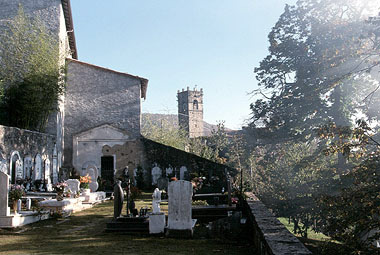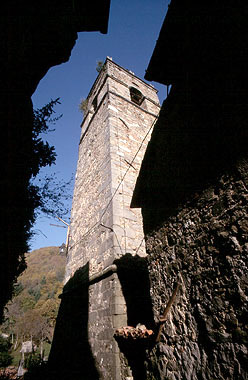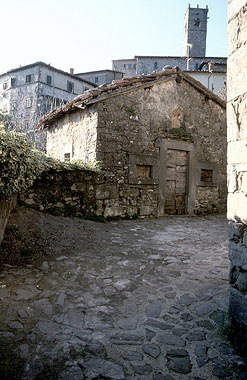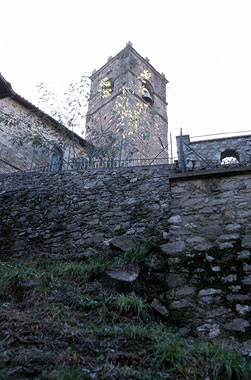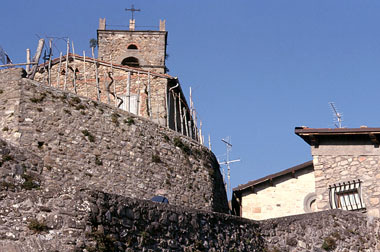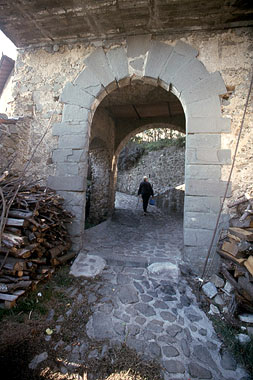Walls of Lupinaia

Information
Address:
Via San Pietro 9a - 55020 - Fosciandora (LU)
Foundation:
Prima metà del sec. XVII Fortified complex is medieval
District/Location:
Fosciandora, locality Lupinaia
District:
Garfagnana

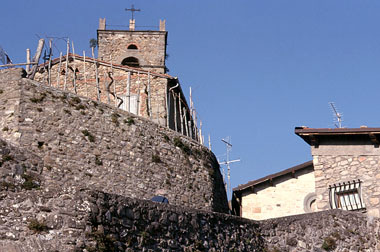
The small village of Lupinaia lies on a buttress of the Apennines gently sloping down towards the Serchio river bed.
It is situated along one of the ancient footpaths connecting Barga with Castelnuovo on the left bank of the river.
The surrounding landscape shows signs of century-long human presence and terraces mark the hillsides with their rows of vines.
The village is in a raised position and had an important strategic role: from here the military garrisons on the further bank of the Serchio could easily be seen and the passage along the valley controlled.
An ancient circle of walls, which originally possessed two doors, one of which still well preserved, protected the village.
At the highest point we find the rocca, composed of a high vertical enceinte which used to contain a XVIth century tower: these two structures formed the strongest and best defended part of the complex.
All around the fortified complex, in concentric rings following the morphology of the ground, we can see the houses of the historic village centre.
It is situated along one of the ancient footpaths connecting Barga with Castelnuovo on the left bank of the river.
The surrounding landscape shows signs of century-long human presence and terraces mark the hillsides with their rows of vines.
The village is in a raised position and had an important strategic role: from here the military garrisons on the further bank of the Serchio could easily be seen and the passage along the valley controlled.
An ancient circle of walls, which originally possessed two doors, one of which still well preserved, protected the village.
At the highest point we find the rocca, composed of a high vertical enceinte which used to contain a XVIth century tower: these two structures formed the strongest and best defended part of the complex.
All around the fortified complex, in concentric rings following the morphology of the ground, we can see the houses of the historic village centre.
Fosciandora, località Lupinaia
LIt is now difficult to appreciate the fortification since most of the walls are incorporated in private houses; only a few portions can still be seen together with the entrance gate. The walls are made of roughly hewn and irregularly disposed local stone.
Nothing remains of the massive towers described in XIXth century sources; they may have collapsed because of their age or during the earthquake that hit the upper Serchio valley in 1920 causing extensive damage.
The rocca and the tower, the latter now a bell tower, have been recently restored: during the restoration the outer curtain of walls and the staircase inside the tower were reinforced so that this part of the fortifications is now much more evident.
Nothing remains of the massive towers described in XIXth century sources; they may have collapsed because of their age or during the earthquake that hit the upper Serchio valley in 1920 causing extensive damage.
The rocca and the tower, the latter now a bell tower, have been recently restored: during the restoration the outer curtain of walls and the staircase inside the tower were reinforced so that this part of the fortifications is now much more evident.
The village is very old and already mentioned in Early Medieval documents; it was contended by Barga, Gallicano and Castiglione. After most of the communities in Garfagnana had willingly surrendered to the Ferrara branch of the Dukes of Este, Lupinaia, together with a few others, preferred to remain loyal to the Republic of Lucca when the neighbouring villages of Ceserana and Fosciandora, under the Este family, became outposts on Lucca's territory. This conferred to the small village of Lupinaia a new importance as fortified garrison in a strip of land between the territory of the Este to the north and that of the Medici who controlled Barga to the south.
It was fortified since the Middle Ages with simple defences filling the spaces between the houses; the present fortifications, however, were carried out by the Republic of Lucca at the beginning of the XVIIth century, during the war of 1613 caused by a quarrel over the frontiers, when clashes on the territory of Lupinaia prompted the construction of a tower at the top of the village, from which the artillery could attack the nearby rocca of Ceserana controlled by the Este.
When the war finally ended in 1616 the government decided to surround the village with walls to increase the stability of its troubled frontiers and the security of the inhabitants of Lupinaia who had paid a high price in terms of blood during the war. The work cost 2000 scudi and upon its achievement was placed under the command of Captain Pieruccio with a small armed garrison. Only a few years later, in 1635, the same Captain Pieruccio complained about the poor conditions of the building and requested urgent repairs to the guardhouses and walls; these were promptly carried out. From then on, as tensions between the House of Este and the Republic of Lucca gradually eased, a period of decline began for the fort of Lupinaia, as for many others, resulting in the demobilisation of the garrisons and the sale of their buildings to private persons: a part of the walls was used for houses, another pulled down to make way for new roads or gardens; a few remain, together with the gate and several other bits of masonry, significant evidence of the village's past.
It was fortified since the Middle Ages with simple defences filling the spaces between the houses; the present fortifications, however, were carried out by the Republic of Lucca at the beginning of the XVIIth century, during the war of 1613 caused by a quarrel over the frontiers, when clashes on the territory of Lupinaia prompted the construction of a tower at the top of the village, from which the artillery could attack the nearby rocca of Ceserana controlled by the Este.
When the war finally ended in 1616 the government decided to surround the village with walls to increase the stability of its troubled frontiers and the security of the inhabitants of Lupinaia who had paid a high price in terms of blood during the war. The work cost 2000 scudi and upon its achievement was placed under the command of Captain Pieruccio with a small armed garrison. Only a few years later, in 1635, the same Captain Pieruccio complained about the poor conditions of the building and requested urgent repairs to the guardhouses and walls; these were promptly carried out. From then on, as tensions between the House of Este and the Republic of Lucca gradually eased, a period of decline began for the fort of Lupinaia, as for many others, resulting in the demobilisation of the garrisons and the sale of their buildings to private persons: a part of the walls was used for houses, another pulled down to make way for new roads or gardens; a few remain, together with the gate and several other bits of masonry, significant evidence of the village's past.
Scopri altre attrazioni vicino a Walls of Lupinaia
See allYou may also like..
See allFind more
0








